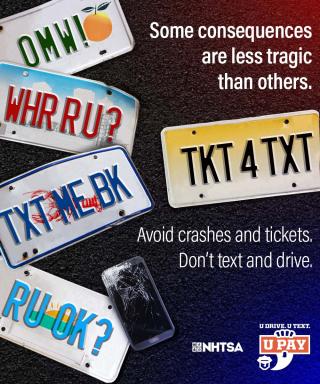April is Distracted Driving Awareness Month

Update: More than 50 additional traffic stops were conducted during the special enforcement period. See Follow-Up Document at the bottom of this page for details.
The Seaside Police Department and the U.S. Department of Transportation’s National Highway Traffic Safety Administration (NHTSA) are teaming up to make our roads safer by enforcing texting and distracted driving laws.
According to the NHTSA, 26,004 people died in crashes involving a distracted driver from 2012 to 2019. While fatalities from all motor vehicle crashes have decreased slightly since 2018, distracted-related fatalities have increased 10%. The number of deaths linked to driver distraction was 9% of all fatalities in 2019. Millennials and Generation Z are the most distracted drivers, often using cell phones to talk, text, and scroll while behind the wheel.
Violating Oregon’s distracted-driving laws can be costly. "ORS 811.507 Operating motor vehicle while using mobile electronic device" is a class B traffic violation; first time offense carries a $265 fine. A second conviction in a 10-year period is treated as a class A traffic violation, carrying a $440 fine. A third or subsequent conviction within a 10-year period preceding the date of the person’s current conviction is treated as a Class B misdemeanor (crime). In addition to any other sentence that may be imposed, the court shall impose a minimum fine of $2,000 on a person convicted of a Class B Misdemeanor.
The SPD and NHTSA urge drivers to put their phone away when behind the wheel. If you need to text, pull over. If you are the driver, follow these steps:
- If you are expecting a text message or need to send one, pull over and park your car in a safe location. Once you are safely off the road and parked, it is safe to text.
- Ask your passenger to be your “designated texter.” Allow them access to your phone to respond to calls or messages.
- Do not engage in social media scrolling or messaging while driving.
- Cell phone use is habit-forming. Activate your phone’s “Do Not Disturb” feature, or put your phone in the trunk, glove box, or back seat of your vehicle until you arrive at your destination.
Texting while driving is dangerous and illegal. Break the cycle. Remember: U Drive. U Text. U Pay. For more information, contact Corporal Matthew Brown at (503) 738-6311 or visit www.nhtsa.gov/campaign/distracted-driving.
| Attachment | Size |
|---|---|
| 451.54 KB |